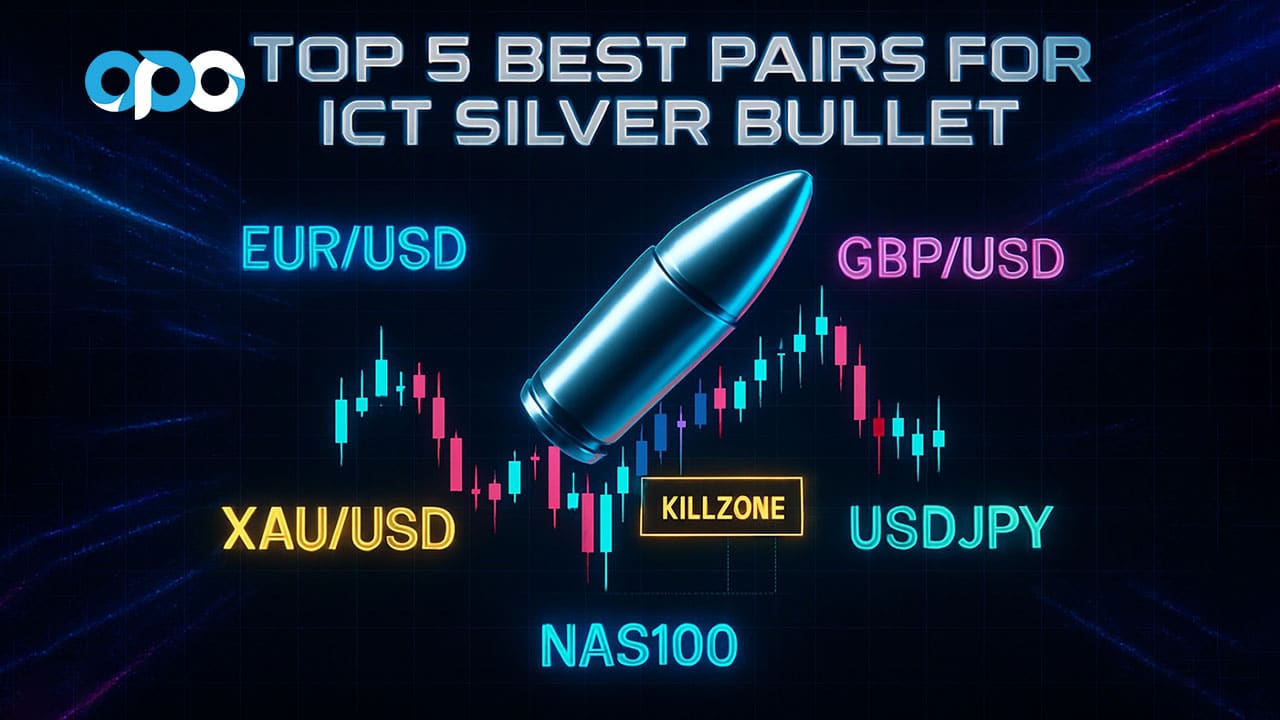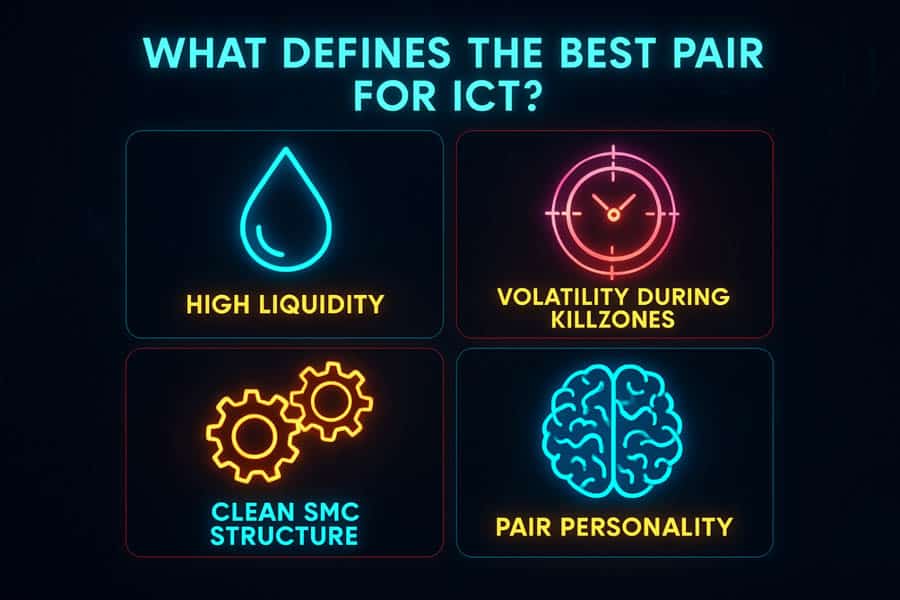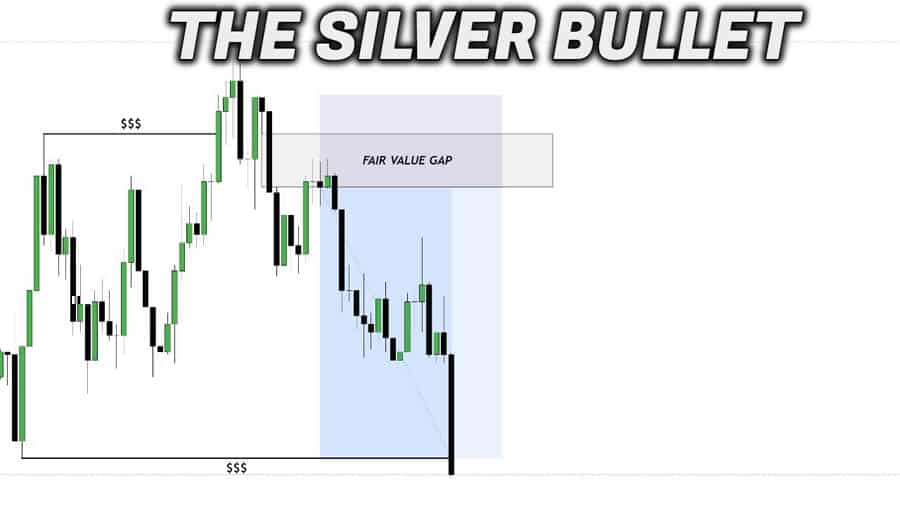The best pairs for ICT Silver Bullet are those with high liquidity and predictable volatility during the specific 1-hour killzones, with EUR/USD and NAS100 being prime examples. Finding the right pair that aligns with this powerful, time-based strategy is crucial for success and can make a significant difference in your trading outcomes. As a trader, choosing a reliable forex broker is the first step, but mastering your strategy on the right asset is what truly builds a profitable career. This article will provide a deep dive into the best pairs for the ICT Silver Bullet, explore ideal setups, and guide you in selecting the pair that best fits your personal trading style and risk tolerance.

Key Takeaways
- Session Is Key: The ICT Silver Bullet strategy is time-dependent. The highest probability setups occur during three specific one-hour windows: London (3-4 AM NY), NY AM (10-11 AM NY), and NY PM (2-3 PM NY). The NY AM session is often considered the most reliable.
- Pair Personality Matters: Not all pairs are created equal. EUR/USD offers consistency and is great for beginners, while GBP/USD provides higher volatility and larger moves. Indices like NAS100 offer multiple setups but come with increased risk. Finding the best pairs for ICT Silver Bullet depends heavily on your personal trading style.
- Core Concepts Are Non-Negotiable: A valid setup requires a clear liquidity sweep, a subsequent Market Structure Shift (MSS), and the formation of a Fair Value Gap (FVG) that price retraces to. Without these core components, the trade is not a Silver Bullet.
- EUR/USD and Indices Dominate: Based on extensive community feedback and personal experience, EUR/USD is often cited as the most consistent and beginner-friendly pair. For more experienced traders, indices like the NAS100 offer the most frequent and potentially profitable opportunities, making them a top choice for finding the Best Pairs for ICT Silver Bullet Strategy.
- Risk Management Is Everything: The strategy provides a clear framework for entry and stop-loss placement (typically above/below the FVG candle). Adhering to this with a minimum 1:2 risk-to-reward ratio is essential for long-term profitability.
Best Pairs for ICT Silver Bullet: A Quick Comparison
Before we dive deep, here’s a high-level look at the most talked-about assets for this strategy. This table summarizes what you can generally expect when looking for the best forex pairs for ICT Silver Bullet and other instruments.
| Pair/Asset | Spreads | Typical Liquidity | Session Fit | Volatility Level | User Experience |
| EUR/USD | Low | Very High | London/NY | Medium | Easiest/highest number of clean setups. Ideal for learners. |
| GBP/USD | Low | High | London/NY | High | Strong, fast moves. Requires tight risk management. |
| USD/JPY | Low | High | Tokyo/NY | Medium | Offers clear trend structure, especially during news. |
| XAU/USD (Gold) | Medium | High | London/NY | Very High | For advanced traders; high reward but prone to volatile sweeps. |
| NAS100/Indices | Variable | Extreme | NY | Extreme | Pro traders’ choice; multiple daily setups with high R/R potential. |
What Defines the ‘Best Pair’ for ICT?

When we talk about the best pairs for the ICT Silver Bullet, we’re not just picking names out of a hat. There’s a science to it, rooted in the core mechanics of the strategy itself. The Silver Bullet is a precision-based model that aims to capture high-probability moves in very short timeframes. Therefore, the “best” pair is one whose natural behavior aligns perfectly with the strategy’s requirements. It’s about creating a trading environment where the odds are stacked in your favor. Let’s break down the essential criteria.
High Liquidity and Tight Spreads
Liquidity is the bedrock of any sound trading strategy, but for the Silver Bullet, it’s paramount. The strategy begins with a “liquidity hunt”—a raid on previous session highs/lows where a dense cluster of stop-loss orders resides. Highly liquid pairs like EUR/USD and GBP/USD have enormous order books, meaning large institutional players are constantly active, creating the very liquidity pools we aim to exploit. This ensures that the moves are genuine and not just random spikes. Furthermore, high liquidity leads to tighter spreads, which is crucial for a short-term strategy where every pip counts. A wide spread can erode your profits or even stop you out prematurely on a perfectly valid setup.
Volatility During Killzones
The ICT Silver Bullet is not an all-day strategy; it’s designed for specific one-hour windows of peak activity. The best pairs for the ICT Silver Bullet strategy are those that consistently exhibit significant price movement during these “killzones.” The NY AM session (10:00–11:00 AM NY time) is the golden hour because it represents the overlap between the London and New York sessions, two of the world’s largest financial centers. During this window, pairs like EUR/USD, GBP/USD, and indices like NAS100 are flooded with volume and volatility. Trading a pair like AUD/NZD during the NY session would be inefficient, as its primary activity occurs during the Asian session. The goal is to be in the market when the market is moving with intent.
Clean SMC Structure
This is where experience comes into play. Some pairs just “draw” cleaner charts than others. They respect key levels and produce the Smart Money Concepts (SMC) signatures required for the Silver Bullet with textbook clarity. The best forex pairs for ICT Silver Bullet regularly provide clear Fair Value Gaps (FVGs) and decisive Market Structure Shifts (MSS) after a liquidity sweep. A pair that produces messy, overlapping wicks and ambiguous price action will lead to frustration and losses. EUR/USD is renowned for its clean structure, while a more exotic pair might be far more erratic. Your job is to find an asset that speaks the language of SMC fluently.
Understanding Pair Personality
Every trading instrument has a unique “personality.” GBP/USD, for instance, is known for its aggressive and sharp moves. It can deliver substantial profits quickly but will punish hesitation or poor risk management. USD/JPY, on the other hand, tends to trend more smoothly and can be less prone to erratic whipsaws, making it a good candidate for traders who prefer steadier price action. Gold (XAU/USD) is a beast of its own, offering immense pip potential but also notorious for its violent stop hunts. Recognizing these personalities is key to selecting a pair that matches your psychological makeup. The best pairs for ICT Silver Bullet are ultimately the ones you understand intimately.
A Quick Guide to an ICT Silver Bullet Setup
Before we dissect the individual pairs, it’s crucial to have a firm grasp of the trade setup itself. The beauty of the ICT Silver Bullet is its mechanical nature. It’s a repeatable process, a checklist you follow within a specific timeframe. This isn’t about guesswork; it’s about identifying a precise sequence of events. When you’re searching for the best pairs for ICT Silver Bullet, you’re essentially looking for the assets that print this sequence most reliably. Here’s the core framework of what constitutes one of the most sought-after ICT Silver Bullet best setups.
Focus on the 1-Hour Windows
First and foremost, you cannot trade this strategy outside its designated time windows. Attempting to do so is not trading the Silver Bullet. The algorithm, as taught by ICT, is designed to function when institutional order flow is at its peak. These are your hunting grounds:
- London Session: 3:00–4:00 AM New York Time
- NY AM Session: 10:00–11:00 AM New York Time (The most favored and reliable hour)
- NY PM Session: 2:00–3:00 PM New York Time
Set alarms for these times. Your entire focus should be on analyzing the chart in the minutes leading up to and during these specific hours. The best pairs for the ICT Silver Bullet strategy will often show their hand right as these windows open.
The Core SMC Sequence

Within one of these one-hour windows, you are looking for a specific four-step sequence to unfold. This is the heart of the strategy.
- The Liquidity Hunt: The first thing price must do is take out a key liquidity level. This is typically a recent high or low, such as the previous session’s high/low, the previous day’s high/low, or a clear short-term swing point. This move is designed to trigger the stop orders of retail traders and induce them into taking the wrong side of the market.
- The Market Structure Shift (MSS): After the liquidity hunt, you need to see a clear and aggressive reversal. The confirmation of this reversal is the Market Structure Shift. For a bullish setup (after a raid on lows), the MSS occurs when price breaks decisively above a recent lower high. For a bearish setup (after a raid on highs), the MSS is confirmed when price breaks aggressively below a recent higher low. This shift signals that the institutional players who engineered the liquidity hunt are now revealing their true intentions.
- The Fair Value Gap (FVG): The aggressive move that causes the MSS will almost always leave behind an imbalance in price, known as a Fair Value Gap. This is a three-candle pattern where there is a visible gap between the first candle’s high and the third candle’s low (or vice-versa for a bearish FVG). This gap represents an inefficiency in the market that price will often seek to rebalance. This FVG is your entry zone.
- The Entry Trigger: The highest probability entry is when price retraces back into the FVG created after the MSS. You are not chasing the move; you are waiting patiently for the price to come back to you. An entry within the FVG offers a superior price and a logical point to define your risk.
Risk and Trade Management
A perfect entry is meaningless without proper risk management. Your stop-loss should be placed logically just below the low of the FVG’s middle candle for a long position, or just above its high for a short. This contains your risk to a small, defined area. Your target should be the next major liquidity pool in the opposite direction, aiming for a minimum risk-to-reward ratio of 1:2. Many traders aim for a fixed target of 15-20 pips, especially on forex pairs, but the best pairs for ICT Silver Bullet, like indices, can offer much larger potential rewards.
Deep Dive: Top 5 Instruments for ICT Silver Bullet

Now that we understand the criteria and the setup, let’s get into the specifics. I’ve traded these instruments extensively, and each has its own rhythm and quirks when it comes to the Silver Bullet. My goal here is to give you an experience-based perspective that you won’t find in a textbook. We will explore why these are considered the best pairs for ICT Silver Bullet by a large portion of the trading community.
EUR/USD: The Reliable Workhorse
If there were a ‘beginner’s choice’ for this strategy, it would undoubtedly be the Euro/Dollar. In my experience, and from what I’ve seen in trading communities, EUR/USD provides the highest number of clean, textbook setups. Its immense liquidity means that price action is generally smooth and respectful of key institutional levels. You see fewer erratic spikes and more logical, flowing moves, which is exactly what you want when trying to identify a clear MSS and FVG. The spread is razor-thin, ensuring that your entry and exit are as precise as possible. During the London and NY AM killzones, EUR/USD is incredibly active, providing the necessary volatility for the strategy to work. If you are new to the ICT Silver Bullet, I strongly recommend starting with this pair. Master it here, and the lessons will be transferable. It truly is one of the best forex pairs for ICT Silver Bullet.
A typical EUR/USD setup during the 10-11 AM window often involves a sweep of the early London session high or low. The move is usually decisive but not chaotic. After the sweep, the MSS is often very clear on the 1-minute or 5-minute chart, and the resulting FVG is well-defined. Price tends to retrace into this FVG gracefully, allowing for a stress-free entry. The manageable volatility means that a 15-20 pip target is realistic and frequently achieved. This pair helps build confidence because the patterns are consistent and repeatable, making it an ideal instrument to learn the nuances of the Best Pairs for ICT Silver Bullet Strategy.
GBP/USD: The Volatility King
Once you’re comfortable with EUR/USD, you might find yourself looking for more ‘bang for your buck.’ This is where GBP/USD, or “Cable,” comes in. This pair is known for its explosive personality. When it moves, it moves fast and hard, often delivering significantly more pips in a shorter amount of time than EUR/USD. This makes it one of the best pairs for ICT Silver Bullet for traders who can handle higher volatility and are seeking greater rewards. The setups are frequent, especially during the London and NY overlap.
However, this extra power comes with a caveat: it demands absolute discipline. The liquidity raids on Cable can be much sharper and more aggressive. You might see price spike 15-20 pips beyond a high before reversing with force. This is why waiting for a confirmed MSS is non-negotiable here; chasing a move on GBP/USD is a recipe for disaster. Your stop-loss must be respected religiously. But for the disciplined trader, the rewards are substantial. A standard Silver Bullet setup on Cable can easily yield 30+ pips. Many professional traders I know have made their careers focusing solely on this pair during the killzones, cementing its status as a top contender for the best pairs for ICT Silver Bullet.
USD/JPY: The Clean Trend Rider
USD/JPY offers a different flavor. It’s a pair that often exhibits very clean, trending behavior, especially when driven by fundamental news out of the US or Japan. During the NY session, it reacts strongly to US economic data, which can provide the perfect catalyst for a Silver Bullet setup. What I appreciate about USD/JPY is its tendency to have fewer whipsaws compared to the GBP pairs. The price action can feel more methodical and less frantic.
The ICT Silver Bullet best setups on this pair often occur during the NY AM window. The pair will consolidate and then seek liquidity, often from the high or low of the Asian session range. The subsequent MSS and FVG are frequently textbook-perfect. Because it’s less crowded than EUR/USD and GBP/USD, the moves can feel cleaner. It’s an excellent choice for traders who prefer a more measured pace and want to focus on executing the sequence without the noise and anxiety that can come with more volatile pairs. It’s a solid, if sometimes overlooked, candidate for one of the best forex pairs for ICT Silver Bullet.
XAU/USD (Gold): The High-Stakes Game
Trading Gold is not for the faint of heart, but for the experienced ICT trader, it can be incredibly lucrative. Gold moves on a different scale. While you might be aiming for 15 pips on EUR/USD, a standard move on Gold can be 50-100 pips (or 500-1000 points). This makes it perhaps the most profitable instrument for a well-executed Silver Bullet, but also the most dangerous. Gold is notorious for its savage liquidity sweeps that can blow through stop-losses that would be perfectly safe on a forex pair. The spreads are also wider, which needs to be factored into your risk calculation.
To trade Gold successfully with this strategy, MSS confirmation is absolutely critical. You must wait for the market to show its hand decisively before committing. The FVGs on Gold are often large, which means your stop-loss might need to be wider, but the potential reward should compensate for this. The best setups occur in the London and NY sessions when institutional volume is at its highest. If you have mastered risk management and have a calm temperament, Gold can be the ultimate vehicle for the Silver Bullet. It is a specialized choice, but for the pros, it’s certainly among the best pairs for ICT Silver Bullet.
NAS100/Indices: The Setup Machine
For many full-time ICT traders, especially those trading to pass prop firm challenges, US indices like the NAS100 (US100) and US30 are the holy grail. The reason is simple: they offer multiple, high-quality setups almost every single day, exclusively during the New York session. The price action is driven by the opening of the US stock market, which injects an enormous amount of volume and directional intent. This makes the 10-11 AM killzone incredibly potent for indices.
The moves are sharp, fast, and substantial. It’s not uncommon to catch a Silver Bullet trade on NAS100 for 50, 100, or even more points. The structures are often incredibly clean. You’ll see a clear sweep of the morning session’s opening range high or low, followed by a powerful MSS and a pristine FVG. The strategy works so well here because indices are a pure measure of risk-on/risk-off sentiment. The challenge, similar to Gold, is the extreme volatility. Moves can happen in seconds. You need a broker with flawless execution and a platform that doesn’t freeze. The risk is higher, but the reward and frequency of setups are unmatched, making indices the undisputed king for many when it comes to the best pairs for ICT Silver Bullet.
How to Find Your Best ICT Silver Bullet Pair

While I’ve given you my top 5, the journey to finding your personal best pair is a critical part of your development as a trader. What works wonders for me might only be moderately successful for you, and vice versa. Your personality, risk tolerance, and schedule all play a role. The process of discovering your ideal match is systematic, not random. This is how you transition from knowing the theory to achieving consistent results with the best pairs for the ICT Silver Bullet strategy.
Analyze Historical Performance (Backtesting)
This is your homework, and it’s non-negotiable. Pick one or two pairs from the list above. Go back on your charts—TradingView is excellent for this—for the last 3-6 months. Mark out the three killzone hours for every single day. Then, manually scroll through and identify every valid Silver Bullet setup you can find. Was there a liquidity sweep? Did an MSS occur? Was a clean FVG left behind? Document everything. Which pair gave the most setups? Which pair had the cleanest structures? This manual, screen-time-intensive process will build your pattern recognition skills faster than anything else. You will start to see the unique rhythm of each pair and how it behaves during these critical hours. This analysis is the foundation for selecting the best forex pairs for ICT Silver Bullet for your own trading.
Evaluate Spread and Slippage in a Demo
Once you’ve identified a promising candidate from your backtesting, it’s time to move to a demo account. The theoretical world of backtesting is different from live market conditions. In a demo, you can assess the actual spread your broker offers on that pair during the killzones. You can also get a feel for slippage—the difference between your expected entry price and the actual price you get filled at. On a volatile pair like NAS100, this can be significant. Spend at least a few weeks trading your chosen pair in a demo environment to ensure the real-world trading conditions are acceptable and don’t negate the profitability of your setups. This is a crucial step in validating the best pairs for ICT Silver Bullet.
Journal Every Single Trade
Your trading journal is your most valuable asset. For every Silver Bullet session (whether you take a trade or not), you should log your observations. Note the pair, the time, and take screenshots of the setup. If you took a trade, log your entry, stop-loss, take-profit, and the final result. Most importantly, write down your reasoning and your emotional state. Were you confident? Anxious? Did you follow your rules? Over time, your journal will provide you with undeniable data about your performance. You might discover that you are consistently profitable on EUR/USD but tend to make emotional mistakes on GBP/USD. This data-driven feedback loop is how you optimize your performance and confirm which instrument truly is your best pair for ICT Silver Bullet.
Master One Before Adding Another
A common mistake is trying to trade too many pairs at once. You can’t be an expert in everything. Choose ONE pair that showed the most promise in your backtesting and demo trading. Focus on it exclusively. Learn its every nuance. Understand how it reacts to news, how it behaves on Monday mornings versus Friday afternoons, and what its average daily range is. Become a specialist in that one asset. Only after you have achieved consistent profitability with it for several months should you even consider adding a second pair to your watchlist. This singular focus will dramatically accelerate your learning curve and help you master the Best Pairs for ICT Silver Bullet Strategy.
Trade with a Trusted Broker like Opofinance
Your strategy is only as good as your execution. Partnering with a regulated and innovative broker like Opofinance, which is regulated by ASIC, can provide the tools you need to trade the ICT Silver Bullet effectively.
- Advanced Trading Platforms: Choose from MT4, MT5, cTrader, and the proprietary OpoTrade platform for reliable execution.
- Innovative AI Tools: Leverage the AI Market Analyzer, AI Coach, and 24/7 AI Support to enhance your decision-making.
- Social & Prop Trading: Explore different trading avenues with integrated social and prop trading features.
- Secure & Flexible Transactions: Benefit from safe, convenient deposits and withdrawals, including crypto payments with zero fees.

Take your trading to the next level. Explore Opofinance today!
Conclusion
In the end, finding the best pairs for ICT Silver Bullet is a journey of discovery that blends technical analysis with personal experience. While EUR/USD and NAS100 often top the list due to their clean structures and high-profit potential, the truly best pair is the one you can trade with discipline and confidence. By systematically backtesting, demo trading, and journaling, you can identify the instrument that aligns perfectly with your style. Master the setup on one pair, understand its personality, and you will unlock the full potential of this powerful, time-based trading model.
Can the ICT Silver Bullet be used on any timeframe?
No, the strategy is specifically designed for execution on lower timeframes (like the 1-minute or 5-minute chart) but only within the three designated one-hour killzones. The higher timeframe bias (1H/4H) is used for directional context, not for the entry itself.
What is the minimum recommended risk-to-reward ratio?
A minimum risk-to-reward ratio of 1:2 is highly recommended. This ensures that your winning trades are significantly larger than your losing trades, allowing for long-term profitability even if your win rate is not exceptionally high.
Is the NY PM session (2-3 PM) as good as the AM session?
Generally, the NY AM session (10-11 AM) is considered the highest probability window due to the London/NY overlap and peak volume. The PM session can still offer valid setups, but it often has less volatility and might be more suitable for targeting smaller moves or scaling out of positions.
Do I need a special indicator for the ICT Silver Bullet?
No, you do not need any special custom indicators. The strategy is traded using pure price action. The only tools required are the ability to identify session times, draw highs/lows, and spot Fair Value Gaps on a clean chart. Some traders use indicators to highlight the killzone hours, but this is for convenience, not a requirement.







